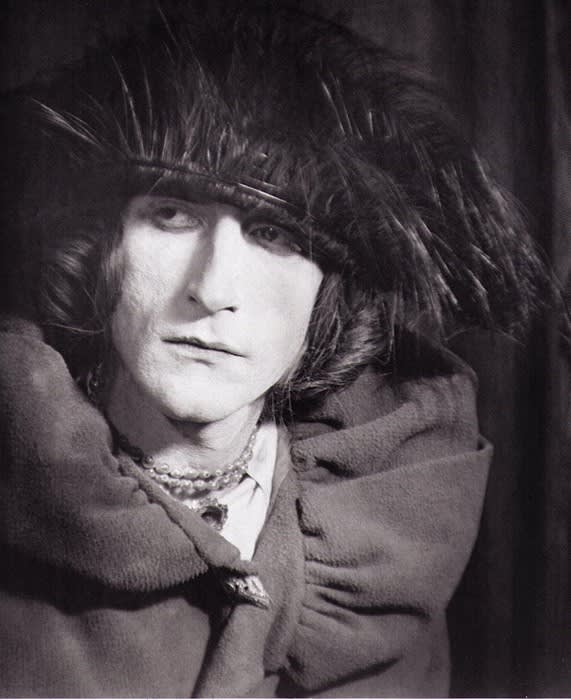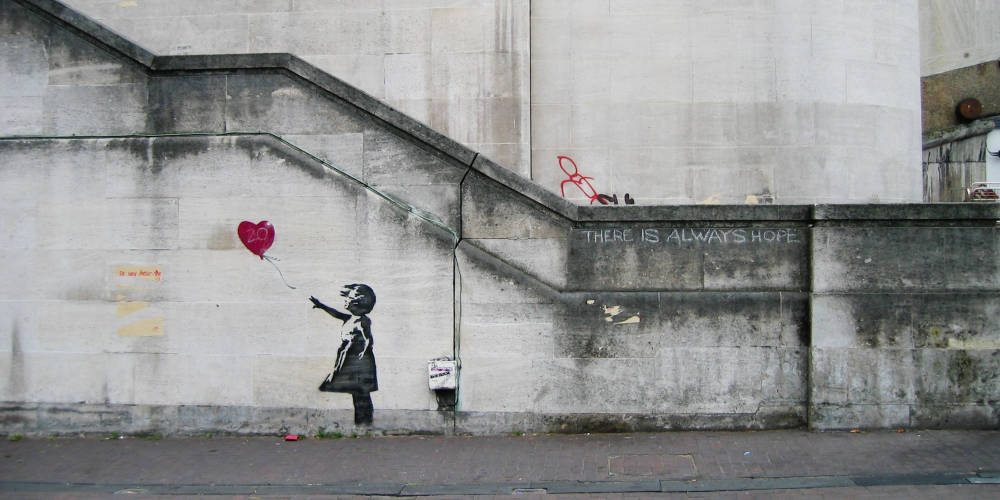
Demna Gvasalia and Kim Kardashian
MET Gala, 2021
While celebrity is celebrated, there’s power in anonymity which we see at work in art, fashion, music, & crypto. It shifts the focus from who you are to what you do — from artist to art, from person to their deeds.
What Matter Who’s Speaking?
People do love their celebrities — and the art world is no different. Art stars abound, helping galleries move product and museums attract visitors. But there’s an inherent tension, if not in fact an absurdity: are we admiring the art or the artist? If Jeff Koons stood in a museum, would most people even notice? Why would — why should — they? But a 12 foot tall glimmering blue balloon dog? That’s of note.

Jeff Koons, “Balloon Dog,” 1994–2000
So, to quote Samuel Beckett, “What matter who’s speaking?” The French thinker, Michel Foucault, who quotes Beckett in his famous essay, “What is an Author?,” repeatedly suggested that all books in France be published for a year without any authorial attribution. His point? That it’s what someone writes that matters, not who they are. Perhaps if critics and readers didn’t pre-judge books based on authorship, we’d see a realignment of what’s considered great — and what isn’t.
Foucault was one of the great critics of personal identity as a fixed thing. He argues that this notion of a true self hidden within us spawned a mode of total control. Rather than being someone who committed a crime, you are a criminal all the way to the bottom of your soul. You’re trapped for life in an identity. For Foucault, this insistence on identity is dangerous — and lazy: it allows us to ignore what someone actually says and does simply because we know who they are.

Man Ray, “Portrait of Rrose Sélavy,” 1921
For Foucault, as well as for a litany of artists and postmodern thinkers, anonymity offers a certain kind of freedom. Marcel Duchamp, for example, had an alter ego, Rrose Sélavy, that first appeared in Man Ray’s photographs in the 1920s. Without a “true” self, Rrose Sélavy’s portraits freely alternate between masculine and feminine, playfully eluding the identity police that would insist you be one or the other. When we’re untethered from “who we are,” we are free to do all kinds of things, to become other to ourselves — a freedom many artists have enjoyed.
Indeed, as private lives become increasingly public thanks to the digitally enabled, hyperconnected world in which we live, discussions around personal data and privacy seem more relevant than ever. In reality, though, privacy issues have existed in different forms for centuries, with the unquantifiable value of personal anonymity holding particular utility throughout the history of art, fashion, and music. Whether artists remain anonymous by choice, alter-ego, or because their identities were unintentionally lost to time, these creators are walking contradictions: famed and unknown.

Anonymous, “Virgin and Child in Landscape,” 1491
The Unintentional Anonymity of the Old Masters
The anonymous European painters who contributed significant work from before the early 19th century are known as “Old Masters,” marking a period when unidentifiable works were attributed to an invented name or artistic category to avoid confusion in cataloging and allow historians to group like paintings. Some of these “no-names” are based on a single work, such as “Master of the Embroidered Foliage,” known for painting “Virgin and Child in a Landscape” in 1491. While the artists’ identities will probably remain anonymous indefinitely, they will live on in oil paint and canvas for centuries to come.
Anonymity as Evasion: Graffiti, Banksy, SAMO
Unlike these unintentionally anonymous Renaissance figures, other artists remain incognito by choice, perhaps the most celebrated contemporary example being the England-based street artist Banksy. Emerging from Bristol’s underground art scene, Banksy’s dedication to his anonymity stems from the illegal nature of graffiti. Although the artist has never confirmed his identity, he is commonly believed to be graffiti artist Robin Gunningham.

Banksy, “Girl with Balloon,” 2002
Active since the 1990s, Banksy’s most well-known projects combine satire with social activism through stenciled graffiti. His art is displayed publicly on walls and self-built props around the world; in recent years, his creative output has expanded to include film directing and works that satisfy the more traditional definition of “fine art.” Perhaps his most subversive commentary on the contemporary art world was “Love is in the Bin” which initially sold at a Sotheby’s auction in 2018 for nearly $1.4 million. Shortly after the bidding was closed, an alarm inside the work’s frame activated a hidden shredder, shredding part of the painting. The stunt was undoubtedly an act of defiance directed at both collectors and the overall market, while drawing attention to the transitory nature of the image. Perhaps unsurprising given the amount of press attention the stunt garnered, the same painting sold again in October 2021 for $25.4 million, making it Banksy’s most expensive work ever sold at auction. Anonymous though he may be, Banksy was plastered all over the internet and social media for weeks following the momentous sale.
Despite being one of the most famous unknown artists working today, Banksy is by no means the first to adopt an anonymous persona. Given the illegal nature of graffiti, most street artists use their distinctive style and unique tag as a form of identity. The graffiti tag SAMO (written SAMO©), for example, emerged in New York’s underground art scene beginning in 1980 and was primarily associated with Jean-Michel Basquiat, though it was originally conceived through a collaboration between Basquiat and New York-based graffiti artist Al Diaz, who would later resurrect the tag.
The Anonymous Body in Fashion & Music: Margiela, Kim Kardashian, & Daft Punk
While fine artists can readily claim anonymity, letting their artwork speak for them, in other arts such as fashion and music, the body of the artist is unavoidable. Which makes anonymity more of a challenge.
In a deft feat, Belgian designer Martin Margiela successfully ran his namesake label for over 20 years while remaining completely anonymous — prohibiting press backstage at his shows, never posing for photographs, and only granting interviews in the third person via fax or, later, email. An archetype for those who came after him, Margiela’s work remains widely influential today, while concepts of anonymity were, and still are, central to the Maison Margiela design philosophy. The brand often rejects the necessity of the body to fashion — frequently obscuring models’ faces on the runway — while garments are often marked by four white stitches in lieu of a traditionally branded label.
Margiela’s ideology of remaining anonymous has even spread to celebrity culture in recent years. The contradiction of fame and anonymity can be seen best in Kim Kardashian’s 2021 Met Gala ensemble. Designed by Demna Gvasalia for Balenciaga, Kim’s all-black t-shirt gown with a matching mask and train obscured the media personality’s famous face, effectively transforming her into a blank silhouette, recognizable only though her trademark curves — perhaps a subtle yet direct nod to the fact that Kardashian is in fact so famous you needn’t even need to see her face to know it’s her.

Demna Gvasalia and Kim Kardashian
In Balenciaga, MET Gala, 2021

Kim Kardashian
In Balenciaga, MET Gala, 2021

Kim Kardashian
In Balenciaga, MET Gala, 2021

Kim Kardashian
In Balenciaga, MET Gala, 2021

Kim Kardashian
In Balenciaga, MET Gala, 2021
A similar contradiction is on display in the musical duo Daft Punk. The French electronic group appeared with their faces obscured beginning in the 1990s, using everything from Halloween masks to black bags to conceal their identities, until the releases of their 2001 album Discovery, at which time the pair started wearing robot-like helmets fit with LED displays and ventilators for performances. While Daft Punk announced their split in 2021, the music duo will forever be synonymous with their masks rather than their faces.

Daft Punk
Anonymity as Cornerstone: Satoshi, PFPs, & Beyond
While the history of anonymity in the creative arts dates back centuries, the more recent introduction of cryptocurrency and blockchain technologies have given rise to an entirely new community of anonymous creators. In 2007, an individual (or collective) going by the name of Satoshi Nakamoto began writing code for what would eventually change the landscape of the internet: Bitcoin. Despite the digital currency’s overwhelming success, the author of this code remains unknown, except for the “Satoshi Nakamoto” pseudonym developed by its creator (or possible creators).
Perhaps it comes as no surprise that this anonymous figure has helped usher in an entirely new decentralized digital frontier known as Web3, where traditional notions of identity are as foreign as the idea of paying for a Starbucks coffee with cash. In a digitally enabled world where “users” are identified primarily by a string of numbers, letters, and QR codes, who’s to say what identity will look like or even mean to future generations.

Punk6529
Just look at PFPs (profile pictures). Across social media platforms, we see a proliferation of images and voices instead of what we think of as “names.” These are not just artworks a real person shows off. PFPs are real and, like traditional identity, are singular. They just present a different notion of identity that isn’t state or family sanctioned. It’s important to note that while PFPs and crypto wallet addresses are indeed anonymous, the fact that they are on the blockchain means their transactions are visible to everyone. That’s what the blockchain is, after all: a public ledger. So while you might not know the “real” identity of, say, Punk6529, you can see “his” activity.
For Satoshi and many Web3 proponents, as for Foucault, what matters is what you do, not who you are. For while you may be anonymous on the blockchain, all of your transactions are transparent, recorded on chain for all to see. Bad actors will out — not based on who they are but on what they do. Perhaps, then, the very nature of celebrity and authorship will change, putting an emphasis on the work rather than the person. Vive l’art! Vive la liberté!


